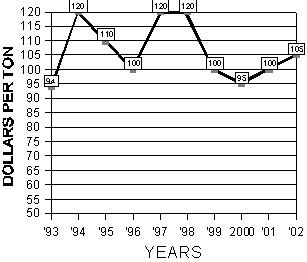Alfalfa Report
Yuma County, Arizona
February 11, 2002
Yuma County Office
2200 W. 28th Street, Ste. 102
Yuma, AZ 85364
(928) 726-3904
(928) 726-8472 FAX
Production Update:
PDF version, 60KB
Hay Preservatives (Part 2): Chemical hay preservatives include organic acids (especially propionic acid), ammonia, and urea. Propionic acid is generally thought to be the most reliable preservative, although other compounds are also effective. Horses do not relish hay treated with propionic acid, although no evidence exists to date that this compound is harmful to them. Ammonia can be used as a preservative and is often applied in an effort to boost feed value of low quality hay. Anhydrous ammonia applied at rates greater than 3% may cause toxic compounds to form and pass into milk. Urea does not have the volatility and safety problems of ammonia and is an effective preservative.
Insect Management: Clover
root curculio adults are small gray and brown mottled weevils that
are often confused with Egyptian
alfalfa weevil adults (PDF file, 48KB) (
photo).
Clover root curculio adults have a short blunt snout and are about 2/3
the size of alfalfa weevil adults which have a longer pointed snout. Little
is known about the potential damage from clover root curculio. The adults
feed on foliage and stems and do not cause economic damage. Larvae feed
on roots and on some occasions may cause damage, but the seriousness of
this damage has not been assessed. No treatment recommendations exist
for this pest. It is important not to confuse the clove root curculio
with Egyptian alfalfa weevil.
Weed Control: DON'T
WAIT, now is the time to apply preemergence
herbicides (PDF
file, 26 KB) for summer annual weeds. These weeds could germinate
any time now on unshaded soil or in areas where soil temperatures are
higher. Remember that it is better to be a month early than a day late.
| Market Summary |
High
|
Low
|
Average
|
Off grade
|
| Past 2 Weeks (Jan 29, 2002 - Feb 10, 2002) |
115
|
100
|
105
|
90-100
|
| Last Year (Jan 29, 2001 - Feb 10, 2001) |
105
|
95
|
100
|
70-90
|
10 Year Summary (January 29, to February 10, 1993 - 2002):

Issued in furtherance of Cooperative Extension work, acts of May 8 and June 30, 1914, in cooperation with the U.S. Department of Agriculture, James A. Christenson, Director Cooperative Extension, College of Agriculture and Life Sciences, The University of Arizona.
The University of Arizona is an equal opportunity, affirmative action institution. The University does not discriminate on the basis of race, color, religion, sex, national origin, age, disability, veteran status, or sexual orientation in its programs and activities.
Any products, services, or organizations that are
mentioned, shown, or indirectly implied in this web document do not imply
endorsement by The University of Arizona.
Information provided by:
Barry Tickes, btickes@ag.arizona.edu Extension Agent, Yuma County
Michael Ottman, mottman@ag.arizona.edu Agronomy Specialist
College of Agriculture, The University of Arizona.
Eric Natwick, etnatwick@ucdavis.edu UCCE Imperial County - Farm Advisor
University of California, Davis, CA.
Forages: Crop Mgmt | Soil Mgmt | Irrigation | Alfalfa Reports | Insects | Diseases | Weeds | Pesticides
Home | Other Crops | Forages
For more Arizona Production Ag Information:
Home | Cotton | Veggies| Forages | Grains | Citrus | Crop x Crop | Insects | Diseases| Weeds | Pesticides | News | Weather | Research | Photos | Contacts | General Info. | Site Map
Copyright © 2001 University of Arizona,
College of Agriculture and Life Sciences
Webmaster: Al Fournier (fournier@ag.arizona.edu)